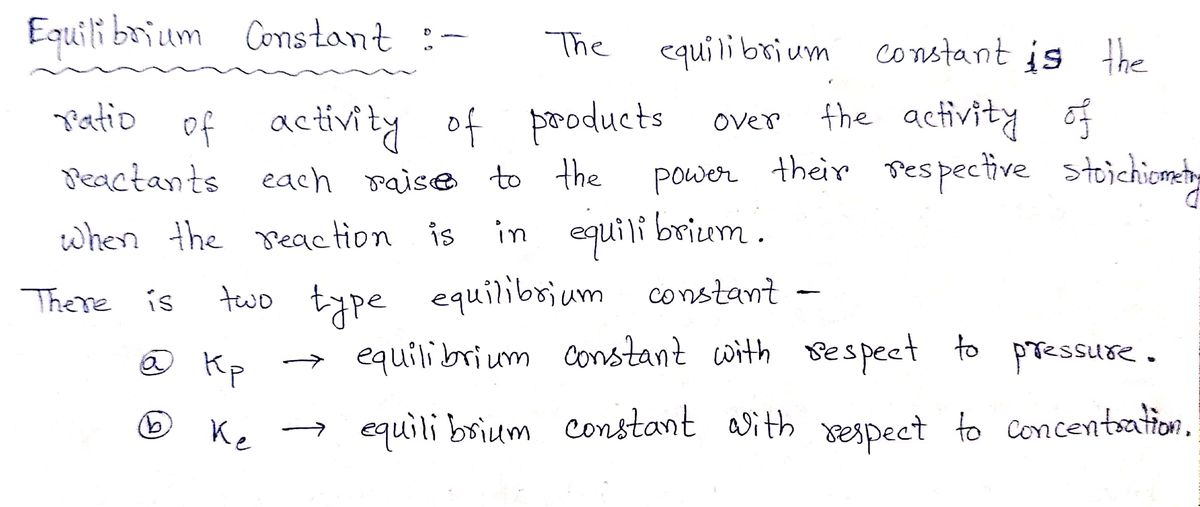Review I Constants I Periodic Table Phosgene (carbonyl chloride), COClą, is an extremely toxic gas that is used in manufacturing certain dyes and plastics. Phosgene can be produced by reacting carbon monoxide and chlorine gas at hi temperatures: CO(g) + Cl₂ (g) COC12 (g) Carbon monoxide and chlorine gas are allowed to react in a sealed vessel at 453 °C. At equilibrium, the concentrations were measured and the following results obtained: What is the equilibrium constant, Kp, of this reaction? Express your answer numerically. View Available Hint(s) Kp = Submit VE ΑΣΦ Part B 4 ? The following reaction was performed in a sealed vessel at 734 °C: D Gas Deriving concentrations from data In Part A, you were given the equilibrium pressures, which could be plugged directly into the formula for K. In Part however, you will be given initial concentrations and only one equilibrium concentration. You must use this data to find all three equilibrium concentrations before you can apply the formula for K. CO Cl₂ COCI Partial Pressure (atm) 0.790 1.28 0.180 H₂(g) + 12(g) 2HI(g) Initially, only H₂ and I were present at concentrations of [H₂] = 3.75 M and [1₂] = 2.80M. The equilibrium concentration of I₂ is 0.0900 M. What is the equilibrium constant, Ke, for the reaction at this temperature? Express your answer numerically. View Available Hint(s)
Thermochemistry
Thermochemistry can be considered as a branch of thermodynamics that deals with the connections between warmth, work, and various types of energy, formed because of different synthetic and actual cycles. Thermochemistry describes the energy changes that occur as a result of reactions or chemical changes in a substance.
Exergonic Reaction
The term exergonic is derived from the Greek word in which ‘ergon’ means work and exergonic means ‘work outside’. Exergonic reactions releases work energy. Exergonic reactions are different from exothermic reactions, the one that releases only heat energy during the course of the reaction. So, exothermic reaction is one type of exergonic reaction. Exergonic reaction releases work energy in different forms like heat, light or sound. For example, a glow stick releases light making that an exergonic reaction and not an exothermic reaction since no heat is released. Even endothermic reactions at very high temperature are exergonic.
![## Equilibrium Constant and Reaction Data Analysis
**Overview:**
Phosgene (carbonyl chloride), COCl₂, is an extremely toxic gas used in manufacturing dyes and plastics. It can be produced by reacting carbon monoxide and chlorine gas at high temperatures.
### Reaction:
\[ \text{CO}(g) + \text{Cl}_2(g) \rightleftharpoons \text{COCl}_2(g) \]
Carbon monoxide and chlorine gas were allowed to react in a sealed vessel at 453°C. At equilibrium, the concentrations were measured with the following results:
**Table of Partial Pressures:**
| Gas | Partial Pressure (atm) |
|---------|------------------------|
| CO | 0.790 |
| Cl₂ | 1.28 |
| COCl₂ | 0.180 |
**Question:**
What is the equilibrium constant, \( K_p \), of this reaction?
Express your answer numerically.
\[ K_p = \] [Text box for answer input]
**Submit Button**
---
**Deriving Concentrations from Data:**
In Part A, you were given equilibrium pressures to input directly into the formula for \( K \). In Part B, however, you will be given initial concentrations and only one equilibrium concentration. Derive all three equilibrium concentrations before applying the formula for \( K \).
### Part B:
The following reaction was performed in a sealed vessel at 734°C:
\[ \text{H}_2(g) + \text{I}_2(g) \rightleftharpoons 2\text{HI}(g) \]
Initially, only \(\text{H}_2\) and \(\text{I}_2\) were present at concentrations of \([\text{H}_2] = 3.75\,M\) and \([\text{I}_2] = 2.80\,M\). The equilibrium concentration of \(\text{I}_2\) is \(0.0900\,M\). What is the equilibrium constant, \( K_c \), for this reaction at this temperature?
Express your answer numerically.
\[ K_c = \] [Text box for answer input]
**Resources:**
- View Available Hint(s)
**Submit Button**](/v2/_next/image?url=https%3A%2F%2Fcontent.bartleby.com%2Fqna-images%2Fquestion%2F1205cd08-0e41-4ad8-bd1c-6b97372ee2c1%2F6e9b5edb-9441-451d-b52a-b8b36b6a177d%2F0vpnecc_processed.jpeg&w=3840&q=75)

Step by step
Solved in 4 steps with 4 images









